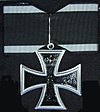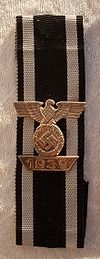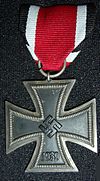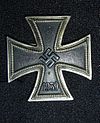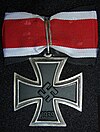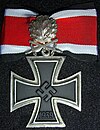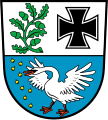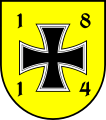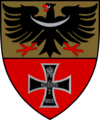Iron Cross
The Iron Cross (EK) was originally a Prussian , later a German war award given by the Prussian King Friedrich Wilhelm III. on March 10, 1813 in Breslau for the course of the liberation war in three classes. The first iron cross was awarded to Friedrich Wilhelm III. posthumously to his wife Luise .
The foundation of the Iron Cross was repeated by King Wilhelm I of Prussia with the outbreak of the Franco-Prussian War on July 19, 1870. Emperor Wilhelm II, in his capacity as Prussian King, renewed the foundation on August 8, 1914 and implemented the Iron Cross his broad-based practice of awarding a quasi-German order. With the fourth foundation at the beginning of the Second World War by the National Socialist dictator Adolf Hitler , the Iron Cross officially became a German award on September 1, 1939, which was initially to be awarded in four classes.
Shape, historical origin and way of wearing
Form and historical origin

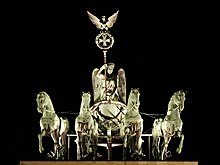


Wars of Liberation 1813 to 1815
The occasion of the foundation of the order gave the beginning wars of liberation against the domination of Napoleonic France in Central Europe, to which Friedrich Wilhelm III. shortly before with his proclamation to my people, also issued in Breslau on March 17, 1813 . Based on a drawing by the king, Karl Friedrich Schinkel was commissioned on March 13, 1813 to create a corresponding final drawing. Literally it says:
"Sr. Royal Maj. Have decided to allow a peculiar award of merit to occur for the duration of the present war. It is said to consist of a black cast iron cross set in silver, the front of which remains completely smooth and without any inscription, but the reverse side at the top contains the name FW with the crown, in the middle three oak leaves, under the year 1813. Se. Maj. Have designed the attached drawing of it themselves and wish a clean drawing. "
Friedrich Wilhelm III. Founded the Iron Cross, the very first award in Germany, for which outstanding actions in the war of liberation were decisive regardless of rank, origin, rank and military rank. In addition to the incipient award practice, there was also the fact that with the introduction of general conscription, all class differences had disappeared. With the foundation of the Iron Cross, the award of several war medals should also be expressly excluded and only permitted in special exceptional cases. The Iron Cross was also the order in which the award of the next higher level required the achievement of the previous award class.
The by Friedrich Wilhelm III. The class division introduced stipulated that the grand cross as the highest class should be worn as a neck medal and the first class made of fabric was to be sewn onto the skirt of the recipient. The king's thought proved unsuitable. The Iron Cross 1st and 2nd class should now be worn on a ribbon in the buttonhole or on the left side of the chest. To distinguish between the two classes, a pectoral cross in the shape of the iron cross was also worn in addition to the first class. This pectoral cross was not the first class of the order in the original foundation, but only the additional identification of this class. No new ribbon was created for the Iron Cross, but rather the existing black and white ribbon of the Pour le Mérite was used. Karl Friedrich Schinkel took over the final execution . The material of this order , the iron , was symbolic. In contrast to many other common military orders of this era, the Iron Cross was deliberately made without valuable materials. The award, made of simple black cast iron set with silver, stood for the chivalrous fulfillment of duty and restraint of a Prussian soldier and was also intended to allude to the Iron Age of ancient mythology , which was to begin with the new war. Since March 31, 1813, the Prussian state has been collecting gold jewelery from wealthy citizens in exchange for simple iron jewelery (" I gave gold for iron "; "gold for defense, iron for honor"). The political scientist Herfried Münkler also sees a reference to the 1812 Vaterlandslied by the patriotic poet Ernst Moritz Arndt , which begins with the words: "The God who made iron grow, he didn't want any servants ..."
The shape of the new badge was also symbolically charged. The reference to the Balkenkreuz of the Teutonic Order was deliberately sought: a black paw cross with widening bar ends on a white coat, as the Teutonic Knights have been wearing since the 14th century. The war that was now beginning was supposed to be placed in the tradition of the crusades and thus sacralized. The focus of the symbolic world around the Iron Cross was the wife of Friedrich Wilhelm III, Queen Luise. Since her death in 1810, a myth had been spun around her as an exemplary wife, loving mother, Prussian Madonna and martyr, to which the king linked with the Iron Cross. So he dated the deed of foundation , which was printed on March 20, 1813 in the Silesian privileged newspaper , to March 10, Luise's birthday. She was also the first to be awarded the new order, albeit only posthumously. Friedrich Wilhelm attached great importance to the connection between his deceased wife and the new order and criticized his court preacher, Rulemann Friedrich Eylert , because he had given too little attention to this in his sermon in the Potsdam garrison church . The medals were made by the Royal Prussian Iron Foundry .
Franco-German War 1870/1871
It was not until the beginning of the Franco-Prussian War that the Iron Cross was renewed by Wilhelm I on July 19, 1870, the anniversary of his mother Luise's death . It could now not only be awarded to Prussia, but also to citizens of all German federal states. On the occasion of the 25th anniversary of the victory over France (September 1, 1870) , on August 18, 1895, King Wilhelm II donated a silver leaf (officially white metal) consisting of three oak leaves with the anniversary number 25 on it, which is on the ribbon of the EK II was to wear. This oak leaf , which was created in this way for the first time, later served the National Socialists as a guiding principle in the creation of higher levels of the Knight's Cross of the Iron Cross.
As a result, the Iron Cross for the armed conflicts in East Asia 1900/1901 as well as the uprisings in German South West Africa was not awarded again.
First World War

The third foundation of the EK was made by Wilhelm II at the outbreak of the First World War on August 8, 1914. According to the order dated June 4, 1915, holders of the EK from 1870 received a (renewed) award on the ribbon above the silver oak leaves (on the 25th day of victory) with a reduced EK with the year 1914 .
Second World War
The fourth and last foundation of the Iron Cross took place with the beginning of the Second World War on September 1, 1939. Here, too, holders of the EK from 1914 were not awarded a new EK when they received a new award, but a repeat clasp that was on the ribbon or directly above the Original cross was to be worn.
Since the foundation was renewed on the occasion of the war in 1870/71, the plug-in cross became an independent distinction as the Iron Cross 1st Class. The Grand Cross was about twice as large as that of the 2nd and 1st class. The shape of the Grand Cross was adopted for the Knight's Cross of the Iron Cross in 1939 , although this was smaller than the Grand Cross, but larger than the 2nd and 1st class. At its original foundation in 1813, the Iron Cross was smooth on the front. In the later foundation renewals, it always bore the respective foundation date (1870, 1914 and 1939) in relief in the lower cross arm, the Prussian royal crown in the upper cross arm and the royal monogram of monarchs Wilhelm I or Wilhelm II , or the swastika (1939) in the middle of the front. The reverse shows in the versions from 1813, 1870 and 1914 in the lower cross arm the year of the original foundation 1813, in the middle an oak leaf and in the upper cross arm the crowned monogram of King Friedrich Wilhelm III. When the foundation was renewed in 1939, Hitler renounced his initials as Führer and Commander-in-Chief of the Wehrmacht , which was personally sworn in on him. Instead, the swastika , the symbol of the Nazi state, was inserted in the center of the traditional order and the monogram of King Friedrich Wilhelm III was added from the back. and removed the oak leaves. The ratio between EK I and EK II was set at 1: 8 by the Order Department of the Army Personnel Office.
Carrying method
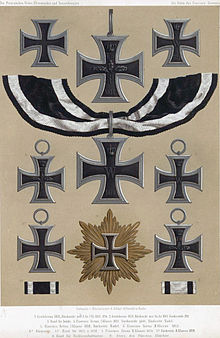
The second class has been worn entirely on the ribbon in the second buttonhole of the uniform jacket since it was first established. Since the middle of the 19th century, the order was only put on in full size on the day it was awarded, and later only on special occasions. The ribbon was sewn to the fabric of the jacket as a sign of the sponsorship. Towards the end of the 19th century, large and small medal clasps were worn, where normally only the ribbon on a brass or sheet metal carrier was also worn on civilian suits.
The first class, the knight's cross and the grand cross were always worn in their original form on the left breast or on the collar.
meaning
The upper class of the Iron Cross was one of the highest Prussian war awards from 1813 to 1918. Only the Royal House Order of Hohenzollern with Swords and the Order Pour le Mérite ( French : for merit; nickname "Blauer Max"), which were reserved exclusively for officers , ranked above this . Teams and NCOs , on the other hand, were awarded the Golden Cross of Military Merit. In the Third Reich, from 1939, the Knight's Cross of the Iron Cross with its individual levels symbolized the highest war award for all rank groups.
Even if there were many other war awards from other states of the German Reich for the armed forces or branches of the armed forces, at no time did they reach the award of an Iron Cross in terms of personal importance and social recognition.
The Iron Cross was the second European Order of War Merit, after the French Legion of Honor , that was awarded regardless of rank or rank , which contributed enormously to its popularity. Perhaps the unique reputation of the order in its time can also be explained by its emphasized simplicity and striking uniqueness among the war orders.
Overview of the foundation data
From 1813
From 1813 to 1918 there were three ascending stages:
- Iron Cross Class II (EK II) (with black and white ribbon)
- Iron Cross 1st Class (EK I) (with black and white ribbon and pectoral cross (1813, see above), or plug-in cross)
- Grand Cross of the Iron Cross (collar)
| Foundation date (1813) | ||||||
|---|---|---|---|---|---|---|
| Iron Cross Class II 1813 (back) | Pectoral cross for the Iron Cross 1st Class 1813 | Grand Cross of the Iron Cross 1813 (back side) ( replica ) | Stern zum Großkreuz 1813 (Blücherstern) ( replica ) | |||
| Foundation date (1870) | ||||||
|---|---|---|---|---|---|---|
| Iron Cross 2nd Class 1870 | Iron Cross 2nd class 1870 with anniversary clasp "25" | Iron Cross 1st Class 1870 | Grand Cross of the Iron Cross 1870 ( replica ) | |||
| Foundation date (1914) | ||||||
|---|---|---|---|---|---|---|
| Iron Cross Class II 1914 (front and back) | Iron Cross 1st Class 1914 | Miniature EK for buttonhole on tailcoat 1914 | Miniature EK for buttonhole on tailcoat 1914 - back | Grand Cross of the Iron Cross 1914 ( replica ) | Star of the Grand Cross 1914 (Hindenburg Star) ( replica ) | |
Iron cross on a white and black ribbon
Although the emphasis was on the appreciation of military achievements, non-combatants could also be awarded the Iron Cross. This group of people was able to receive the Iron Cross on the white and black ribbon for their services that were not related to active combat operations. By 1819 a total of 371 non-combatants had been awarded this award. General Anton Wilhelm von L'Estocq was the first to receive the 2nd class cross. He was followed by another 36 officers, as well as three princely and six people belonging to the court. In addition, eight ministers, 23 high presidents, presidents and vice-presidents, seven diplomats, 97 other administrative officials, 31 landowners, nine domain tenants, 70 doctors, 56 military officials, nine municipal officials, eleven people from the economy and four professors. In contrast to awards for military merits, the Iron Cross on the white and black ribbon could not be inherited.
When the Iron Cross was re-established in 1870 and 1914, the Iron Cross was also created on a white and black ribbon. During the First World War, the pejorative name "Schieberkreuz" came up because the recipients were often people from the armaments industry or logistics .
Blücherstern and Hindenburgstern
The Prussian field marshals Blücher and Hindenburg each received a specially created level of the Iron Cross for their extraordinary services. Here the cross was on a golden eight-pointed star. These crosses, which were only awarded twice, were called " Blücherstern " or " Hindenburgstern " after their bearers . The stars were in the collection of the Berlin Zeughaus until the museum's holdings were relocated at the end of World War II in 1945 . After that they were considered lost. In 2007 the whereabouts of the Blücherstern was clarified. This year, an inventory catalog of the museums of the Moscow Kremlin and the city's State History Museum was published, with the information that the star and the Blucher Grand Cross are in the possession of the State History Museum.
Second World War
In the Second World War , Hitler reintroduced the Iron Cross as a war decoration. Made a little thicker, it was given the year 1939 on the front (1813 was on the back) and the swastika in the middle . It was no longer worn on a black and white ribbon, as in Prussian tradition, but on a black, white and red ribbon (seen from the outside in). The foundations of 1813, 1870 and 1914 included both “bravery in front of the enemy” and non-combat merit in the award regulations. The foundation of 1939 excluded non-combatants from the award for the first time; The War Merit Cross was donated for them and for combatants in the rear area or on the “home front” .
A repeat clasp was created for soldiers who had already been awarded the Iron Cross in the First World War . For EK II 1914 this was worn on the ribbon and for EK I 1914 over EK I (i.e. put on the breast pocket). The size of the clasp is adjusted so that the field with the year looks like a direct continuation of the upper arm of the cross. The clasp itself is silver-colored and consists of the national emblem of that time, a stylized eagle with spread wings, including the year 1939. The so-called 1957 version of the clasp for the EK consists of the year 1939 divided by an EK miniature. The clasps for EK I or EK II differ fundamentally in that the wings of the clasp of EK I protrude beyond the year plate.
In individual cases, women were also awarded EK II. The test pilot Hanna Reitsch was the first woman to receive EK II in 1941. In 1942 she was also the only woman to be awarded EK I. The other women who received EK II were mostly DRK sisters.
In the period from 1939 to 1945, a distinction was made between four ascending stages:
- Iron Cross Class II (EK II) (with black-white-red ribbon)
- Iron Cross 1st class (EK I) (plug-in cross)
- Knight's Cross of the Iron Cross and its higher levels
- Grand Cross of the Iron Cross
| Foundation date (1939) | ||||||||||
|---|---|---|---|---|---|---|---|---|---|---|
| Repeat clasp for the Iron Cross, 2nd class, 1939 | Repeat clasp for the Iron Cross 1st Class 1939 | Iron Cross 2nd class 1939 | Iron Cross 1st Class 1939 | Knight's Cross of the Iron Cross 1939 ( replica ) | Knight's Cross of the Iron Cross 1939 with oak leaves ( replica ) | Knight's Cross of the Iron Cross 1939 with oak leaves and swords ( replica ) | Knight's Cross of the Iron Cross 1939 with oak leaves, swords and diamonds ( replica ) | Knight's Cross of the Iron Cross 1939 with golden oak leaves, swords and diamonds ( replica ) | Grand Cross of the Iron Cross 1939 ( replica ) | Star of the Grand Cross 1939 ( replica ) |
The knight's cross , donated in 1939, was worn on a wide ribbon around the neck (the statute of the order stipulated that the order had to lie on the flat tie knot) and in fact took over the role of the Prussian Pour le Mérite, awarded until 1918, which is only awarded to officers (until 1918 the Golden Military Merit Cross was awarded to men and officers). In the course of the war, oak leaves (816 awards), swords (157 awards) and diamonds (27 awards) were added to the RK, which were attached to the carrying ring of the ribbon, to increase the award for further merits. As a further increase, which was only awarded once, on January 1, 1945, the Stuka pilot Hans-Ulrich Rudel received the Knight's Cross of the Iron Cross with golden oak leaves, swords and diamonds. The last increase was the Grand Cross . This medal was also awarded only once between 1939 and 1945, to Hermann Göring , Commander in Chief of the Air Force and Reichsmarschall .
In 1942 Hitler ordered that bearers of the Knight's Cross should be greeted first as an award by all military ranks (including generals) regardless of the rank of the bearer.
The US Army seized at the end of the war in Austria a special stage of the Grand Cross with star, similar to the 1813 and 1914 Blücher- or Hindenburg star . This award was never presented; for whom it was intended is unknown. Göring's Grand Cross and the never-to-be-awarded star are in the archives of the US Military Academy in West Point .
Award numbers
| Grand Cross of the Iron Cross | 1813/15 | 5 awards: Blücher , Bülow , Crown Prince Karl Johann , Tauentzien , Wartenburg |
|---|---|---|
| 1870/71 | 8 awards: Friedrich Wilhelm von Prussia , Carl von Prussia , Albert von Sachsen , Edwin von Manteuffel , Helmuth von Moltke , August von Goeben , August von Werder , Friedrich Franz II. | |
| 1914/18 | 4 awards: von Hindenburg , von Mackensen , Leopold von Bayern , Ludendorff | |
| 1939/45 | 1 award: Göring | |
| Knight's Cross of the Iron Cross | 1939/45 | 8,397 awards (all levels) |
| Iron Cross 1st Class | 1813/15 | 668 awards |
| 1870/71 | 1,302 awards | |
| 1914/18 | approx. 218,000 awards | |
| 1939/45 | approx. 300,000 awards | |
| Iron Cross 2nd class | 1813/15 | 8,542 (+ 7,000 candidates) + 371 on the white-black ribbon |
| 1870/71 | 47,812 awards including 4,084 awards on the white and black ribbon | |
| 1914/18 | approx. 5,196,000 awards plus 13,000 awards on the white and black ribbon | |
| 1939/45 | approx. 3,000,000 awards |
The Iron Cross from 1945
National emblem of the Bundeswehr and use
A war award has not been issued by a Federal President since 1945, but on October 1, 1956, Theodor Heuss designated the Iron Cross as a symbol of recognition for the aircraft and combat vehicles of the Bundeswehr in view of its identity-creating tradition . It represents the national emblem in all three branches of the armed forces (e.g. on armored vehicles and on aircraft). The top of the armed forces flags is an iron cross surrounded by golden oak leaves. The badge of honor of the Bundeswehr (medal of honor, honor cross in bronze, silver or gold) also bears the iron cross as a symbol of love of freedom, chivalry and bravery on the front. It is also used on letters, business cards and in public relations as the “ umbrella brand ” of the Bundeswehr. The iron cross as a symbol can still be found today in various Bundeswehr association badges.
Association badge of the tank battalion 403 (decommissioned)
Association badge of the tank battalion 413
Association badge of the tank battalion 524
The Iron Cross as a signet of the Bundeswehr
Internal association badge of the Berlin site command
Reintroduction petition 2007
In the spring of 2007 a petition was initiated in the German Bundestag to reintroduce the Iron Cross as an award for bravery by the Bundeswehr for deployments abroad. This petition was signed by over 5,000 people within the prescribed two-month period. The German Bundestag discussed the petition and decided on December 13, 2007 to transfer the petition to the Federal Government - here: the Federal Ministry of Defense (BMVg). He is thus following the resolution recommendation of the Petitions Committee (BT-Drucksache 16/7494).
The president of the reservists' association , Ernst-Reinhard Beck (CDU), suggested using the shape of the Iron Cross for the order. He justified this with the statement that the symbol is carried by all vehicles, aircraft and ships of the Bundeswehr and has meanwhile advanced to a sign of hope, help and solidarity in crisis regions, for which one should not be ashamed. Due to its reintroduction by the National Socialist regime, this was largely rejected. On March 6, 2008, the then Federal President Horst Köhler approved the proposal by Defense Minister Franz Josef Jung (CDU) for an order for “extraordinarily brave deeds”. A revival of the Iron Cross was not considered, but rather an expansion of the existing decoration of the Bundeswehr . As a result, the Bundeswehr Cross of Honor for bravery was donated on October 10, 2008 .
Others
Strap buckles
Use in the Kriegsmarine
The submarine U 9 was due to an order of the Commander of the Navy Erich Raeder , he had issued in spring 1936, entitled, on both sides of the tower the Iron Cross in memory of his predecessor in the First World War SM U 9 to install in the form of a painting, because this imperial boat already led the EK at the tower. Other ships of the Kriegsmarine authorized to lead the EK were the light cruiser Emden , as the successor to the first SMS Emden , and the survey ship Meteor .
How the Iron Cross was worn after 1945
According to the German Order Act of July 26, 1957 , wearing the EK from the Second World War is only permitted without a swastika and with proof of legitimate acquisition. Veterans can purchase iron crosses - also as miniatures - at their own expense, on which the swastika has been replaced by an oak leaf, as it was on the first Iron Cross from 1813. The only well-known German manufacturer and distributor is the Steinhauer & Lück company from Lüdenscheid . Badges with National Socialist emblems may not be worn in public. The possession of originals is allowed. When using and trading, § 86 and § 86a StGB must always be observed. There a clear distinction is made between prohibited (e.g. for National Socialist propaganda) and permitted (e.g. for cultural-historical collections or scientific purposes).
useful information
The name of the Berlin district of Kreuzberg goes back to the National Monument for the Wars of Liberation designed by Schinkel in 1821 and crowned with an Iron Cross , after which Tempelhofer Berg was again renamed Kreuzberg .
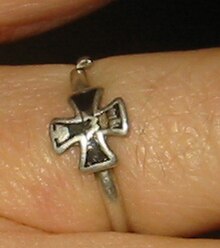
The symbolism of the Iron Cross was used from 1813, after Princess Marianne of Prussia called all women of Prussia to hand over their gold jewelry, also for honorary jewelry, mostly with the inscription "I gave gold for iron". The appeal was repeated during World War I. Wedding rings, brooches and jewelry rings (some of which directly pick up on the symbolism of the Iron Cross) were given to citizens willing to donate in return for their gold jewelry. The German Red Cross collected donations in numerous places during the war with an oversized wooden replica (190 × 190 cm and 14 cm thick) into which iron or silver nails could be driven according to the donation amount (Darmstadt, Heidelberg, Saarbrücken). This "cross in iron" served as a "patriotic attraction" in order to win donors for these donations at the same time and in turn to distinguish donors through the public form.
The Iron Cross can be found in some city coats of arms or as a symbol for associations as well as in churches and chapels, such as B. in the former cemetery chapel in Tettnang . The jewelry industry uses iron crosses as a chain or ring, but also as piercing jewelry . Further distribution examples are:
The Quadriga on the Brandenburg Gate . Goddess Victoria with the lance in her right hand, in which the iron cross in the laurel wreath is visible
Berlin victory column with goddess Victoria
Großbeeren municipal coat of arms
Coat of arms of the Berlin district of Hohenschönhausen
The old coat of arms of Tannenberg
(1916–1945)The coat of arms of Breslau (1938–1945) used during the Nazi era
National monument in Berlin-Kreuzberg
Schill Monument Braunschweig
Use in pop culture
In the late 1960s, the iron cross was increasingly used as a symbol in pop and subculture . American subcultures such as the biker scene and rock musicians made the start. Like many trends, this usage later also caught on in Europe.
The English rock band Motörhead used the symbol as part of their mascot Snaggletooth . Singer and bassist Lemmy Kilmister wore an iron cross as a necklace.
literature
- Winfried Heinemann (Ed.): The Iron Cross. The history of a symbol through the ages (= Potsdam writings on military history . Vol. 24). Commissioned by the German Commission for Military History and the Center for Military History and Social Sciences of the Bundeswehr , Potsdam 2014, ISBN 978-3-941571-30-3 .
- Frank Wernitz : The Iron Cross. 1813 - 1870 - 1914. History and significance of an award (= catalogs of the Bavarian Army Museum Ingolstadt . Vol. 11). With color photos by Georg Schnellnberger, 2 volumes, Verlag Militaria, Vienna 2013, ISBN 978-3-902526-58-8 . (English edition 2013)
- Volume 1: main volume
- Volume 2: Typology [in collaboration with Volker Simons]
- Louis Schneider: The Book of the Iron Cross. Duncker, Berlin 1872. Heinrich Heine University digital
- Werner Otto Hütte: The history of the Iron Cross and its significance for the Prussian and German labeling system from 1813 to the present. Rheinische Friedrich-Wilhelms-Universität Bonn, 1967 (Bonn, Phil. Fac., Diss. Of December 20, 1967).
- Jörg Nimmergut : The Iron Cross 1813–1957. History of the labeling system. Special edition. VDM Heinz Nickel, Zweibrücken 1997, ISBN 3-925480-07-2 .
- Jörg Nimmergut: German medals and decorations until 1945. Central Office for Scientific Order Studies, Munich 2001, ISBN 3-00-001396-2 ,
- Volume 2. Limburg - Reuss. Pp. 1007-1073,
- Volume 4. Württemberg II - German Empire. Pp. 2108-2131.
- Stephen Thomas Previtera: The Iron Time. A History of the Iron Cross. Second edition. Winidore Press, Richmond VA 2007, ISBN 978-0-9673070-3-9 .
- Ralph Winkle: Thanks from the fatherland. A history of symbols of the Iron Cross 1914 to 1936. Klartext, Essen 2007, ISBN 978-3-89861-610-2 (also: Tübingen, Univ., Diss., 2002/03).
- Dietlinde Munzel-Everling : War nailing. Wehrmann in Eisen, Nagel-Roland, Iron Cross. Wiesbaden 2008. Downloadable as PDF .
- Michael Autengruber : 200 years of the Iron Cross. From the Wars of Liberation to the Bundeswehr . In: The Order of St. John in Baden-Württemberg, No. 128, December 2013, pp. 13-17.
- Harald Potempa (ed.): The iron cross. To the history of an award. [Text and picture panels of the special exhibition "The Iron Cross - the history of an award" in the Air Force Museum of the Bundeswehr, from June 12, 2003 to January 4, 2004] (= Air Force Museum: special exhibition . H. 1). Air Force Museum, Berlin-Gatow 2003.
Web links
- Dieter Pohl : Iron Cross: Order for mass murder. In: zeit.de. June 8, 2008, accessed December 16, 2014 .
- PDF version (Latin script) of the 16-page “Silesian privileged newspaper” dated March 20, 1813 with the original text (certificate) by Friedrich Wilhelm on the foundation of the Iron Cross
- Order list of the knights and owners of the Royal Prussian Orders and Decorations in 1817 (incl. List of all bearers of the Iron Cross 1813).
Individual evidence
- ^ Eugène Godet: What you need to know about the Iron Cross , printed in the magazine Uniform Markt , year 1935, issue 2, p. 9.
- ↑ Also on the following Herfried Münkler , The Germans and their Myths , Rowohlt Berlin Verlag, Berlin 2008, pp. 265–269.
- ^ Draft for the Iron Cross , illustration in the website Das Erbe Schinkel of the Kupferstichkabinett of the Staatliche Museen zu Berlin , accessed on the smb.museum portal on November 1, 2013
- ^ Ansgar Reiß (Ed.), Frank Wernitz: Das Eiserne Kreuz 1813-1870-1914. History and meaning of an award (= catalogs of the Bavarian Army Museum Ingolstadt. Volume 11). Verlag Militaria GmbH, Vienna 2013, ISBN 978-3-902526-58-8 , p. 112.
- ↑ Philip Demandt, Luis cult. The immortality of the Queen of Prussia , Böhlau Verlag, Cologne 2003, p. 212.
- ↑ Christoph Rass: Human material: German soldiers on the Eastern Front. Interior views of an infantry division 1939–1945. Schöningh Verlag 2003, p. 253.
- ^ Ansgar Reiß (Ed.), Frank Wernitz: Das Eiserne Kreuz 1813-1870-1914. History and meaning of an award. Catalogs of the Bavarian Army Museum Ingolstadt. Volume 11. Verlag Militaria GmbH. Vienna 2013. ISBN 978-3-902526-58-8 . P. 207.
- ^ A b Ansgar Reiss (Ed.), Frank Wernitz: The Iron Cross 1813-1870-1914. History and meaning of an award. Catalogs of the Bavarian Army Museum Ingolstadt. Volume 11. Verlag Militaria GmbH. Vienna 2013. ISBN 978-3-902526-58-8 . P. 206.
- ^ LM Gavrilova, SS Levin: Evropeyskie ordena v Rossii. Konets XVII – nachalo XX veka. 2007; Review by Order of the World. Michael Autengruber
- ^ Ansgar Reiss (Ed.), Frank Wernitz: Das Eiserne Kreuz 1813-1870-1914, History and Significance of an Award , Catalogs of the Bavarian Army Museum Ingolstadt , Volume 10, Verlag Militaria GmbH, Vienna 2013, ISBN 978-3-902526-58 -8 , p. 170.
- ^ Kurt-Gerhard Klietmann: Awards of the German Empire. Motorbuch, Stuttgart 1981, ISBN 3-87943-689-4 . Pp. 30-36.
- ↑ The award was revoked by Hitler on April 23, 1945 by will, after which Göring was immediately declared forfeit of his political, party-internal and military offices (see the print of the “Testament” in Werner's book Maser Adolf Hitler or Adolf Hitler's Political Testament )
- ^ Ansgar Reiß (Ed.), Frank Wernitz: Das Eiserne Kreuz 1813-1870-1914. History and meaning of an award. Catalogs of the Bavarian Army Museum Ingolstadt. Volume 11. Verlag Militaria GmbH. Vienna 2013. ISBN 978-3-902526-58-8 . Pp. 166-167.
- ^ Ansgar Reiß (Ed.), Frank Wernitz: Das Eiserne Kreuz 1813-1870-1914. History and meaning of an award. Catalogs of the Bavarian Army Museum Ingolstadt. Volume 11. Verlag Militaria GmbH. Vienna 2013. ISBN 978-3-902526-58-8 . Pp. 282-285.
- ^ Ansgar Reiß (Ed.), Frank Wernitz: Das Eiserne Kreuz 1813-1870-1914. History and meaning of an award. Catalogs of the Bavarian Army Museum Ingolstadt. Volume 11. Verlag Militaria GmbH. Vienna 2013. ISBN 978-3-902526-58-8 . Pp. 412-415.
- ↑ According to the Association for German History, cf. Jörg Nimmergut: German medals and decorations until 1945, p. 1043.
- ↑ According to the Association for German History, cf. Jörg Nimmergut: German orders and decorations until 1945, p. 1046.
- ^ Ansgar Reiß (Ed.), Frank Wernitz: Das Eiserne Kreuz 1813-1870-1914. History and meaning of an award. Catalogs of the Bavarian Army Museum Ingolstadt. Volume 11. Verlag Militaria GmbH. Vienna 2013. ISBN 978-3-902526-58-8 . P. 316.
- ^ Ansgar Reiß (Ed.), Frank Wernitz: Das Eiserne Kreuz 1813-1870-1914. History and meaning of an award. Catalogs of the Bavarian Army Museum Ingolstadt. Volume 11. Verlag Militaria GmbH. Vienna 2013. ISBN 978-3-902526-58-8 . P. 402.
- ^ Text of the order of the Federal President on the marking of aircraft and combat vehicles of the Bundeswehr
- ↑ www.bundestag.de ( Memento of the original from December 16, 2014 in the Internet Archive ) Info: The archive link was inserted automatically and has not yet been checked. Please check the original and archive link according to the instructions and then remove this notice. (PDF file)
- ↑ www.arcor.de ( page no longer available , search in web archives ) Info: The link was automatically marked as defective. Please check the link according to the instructions and then remove this notice.
- ↑ Bundeswehr Order: Jung wants medal of bravery - but not an Iron Cross. In: Spiegel Online . March 6, 2008, accessed December 16, 2014 .
- ↑ Koehler for orders of bravery. In: FAZ.net . March 6, 2008, accessed December 16, 2014 .
- ↑ Uniformen Markt magazine, year 1936, article Wehrmachtsrundschau p. 46.
- ^ Dietlinde Munzel-Everling: Kriegsnagelungen. Wehrmann in Eisen, Nagel-Roland, Iron Cross. Wiesbaden 2008, p. 3. (PDF file; 3.5 MB)
- ↑ Review of the book: hsozkult.geschichte.hu-berlin.de







